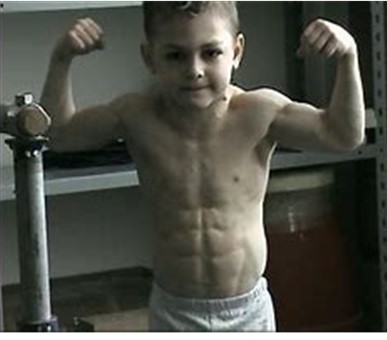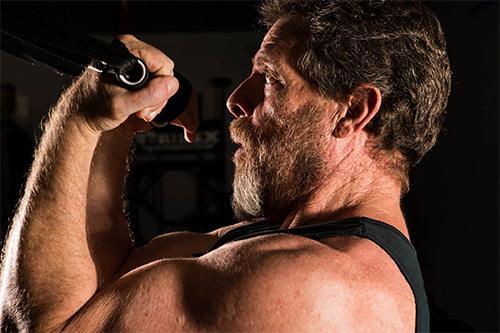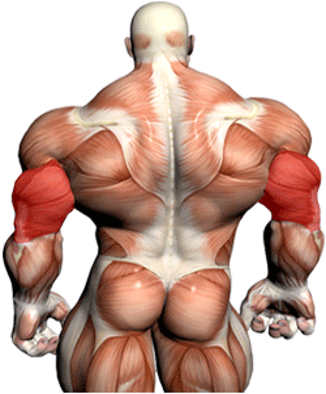
Young Alpha flexes his guns in between getting into trouble!
Oscar Wilde was once asked, what is the purpose of life? He had a two-word answer, “self-improvement.” Self-improvement can occur at age 12 or age 72. Since the beginning of time, humans have sought to improve physically and psychologically. We seek to morph ourselves physically, from what we are into what we want to be. As Albert Camus noted, “Man is the only creature that refuses to be what he is.” We seek betterment psychologically and physically.
Progressive resistance training, done right, is forcible evolution. The human body is no longer sculpted by hunting, killing, sprinting, leaping, fighting, chasing game for miles, lugging slain animals for miles, eternally chopping firewood, fighting off predators, and doing hard physical labor of all type and kind every single day. To sculpt the body, modern man artificially induces and inflicts the molding stresses ancient man routinely underwent in their day to day lives.
Progressive resistance has a seductive lure: the promise of a radical physical transformation. Weight training promised to give me the body I craved, the body all my prepubescent superheroes possessed. The superhero ethos ran deep in me: I was raised on the comic book physiques: Superman, Batman, Green Lantern, Flash, et. al. The super-physique goal was further imprinted when I immersed myself in Greek, Roman, and Norse mythology. Weight training claimed to be the transformative tool. And I had access to a barbell. Thus began a 60 year immersion that continues unabated to this day.

The Hindu mystics have a saying, “the happiest man connects the morning of his life to the evening.” In many ways, I am that man. I now have a unique opportunity. I have a special perspective. I have become an de facto “aging specialist,” an inner astronaut seeking ways and methods that extend life and improve the quality of that extended life.
I was a serious progressive resistance trainer by age 12. By age 17 I was a teenage national Olympic weightlifting champion. I set my most recent age-group national powerlifting records at age 65. I train hardcore to this day. My emphasis and perspective, my goals, naturally, have shifted over time.
As a boy turning into a man, every day I awoke with a new body, one slightly stronger and more robust than the day before. My preteen goals were lofty and fantastical: to forcibly morph from human into superhuman, from spindly into gargantuan. My goal was to become a national and world champion athlete.

As an aging man on the wrong side of 70, every day I awake with a new body, one slightly weaker and less capable than the day before. My late-in-lifegoal is practical and down-to-earth: to improve on my training performances of the previous week. My goal is to retain (some degree of) strength, mobility, flexibility, agility until my inevitable demise. In 1962 I was managing a rapid ascendency and in 2022 I am managing the slowed decline.
As a boy, puberty, the sudden production of testosterone by the male body, came early: age 11. I suspect its onset was prematurely triggered by the near daily limit weight training I lifted continually all the previous year. When my boy body began producing testosterone (by the bucketful) my body exploded. I was able to train harder, heavier, longer, and more often.
I was simultaneously self-educating via my monthly gleaning of training information from the three main muscle magazines, Strength & Health, Iron Man, and Muscle Builder. I attained my full height 5-10 by age 12. I weighed 120 and could overhead press 120. At age 18, I weighed 195 and overhead pressed 270.
From age 11 onward, every morning, I awoke with a stronger, more capable body. Not to say that the muscle and strength curve was one continual, robotic upward sweep, week in, week out. But it sure as hell was a robotic upward, year in, year out for the next ten years. The proof is empirical: I added 55 pounds of muscle and more than doubled my strength in a five year period. It was a muscle growth perfect storm: a stress-free life, lots of calories, lots of cardio (team sports year-round,) all augmented with near daily (always) limit lifting in a broad array of exercises.
As a man on the other side of 70, every morning I awake with an infinitesimal physical degradation. The goal now is to minimize and delay the rate of decay. Now longer do I fret over being able to lift the poundage I did five years ago, now I fret over not being able to match the poundage or reps handled last week.
Up until age 65 I had felt that with six months of intense powerlifting training I could be competitive nationally and internationally in my age group and weight class. I incurred an injury, unrelated to weight training, (torn meniscus) that my legs never bounced back from. Once my competitive aspirations were extinguished, I needed new motivating goals.
From age 70 onward, I took a more relaxed stance: I mix and match cardio exercise with progressive resistance training. I used to perform intense weight training and intense cardio on the same day and bounce back just fine and in time for the next kick-ass cardio/hardcore lifting day. As I got older, I had to put more rest days between dual session days. A few years back I wised up and said to myself, either kick your ass doing cardio or kick your ass lifting – but no more both in the same day. Go all out in one or the other, not both.
My late-in-life favored cardio mode is burst-style sprinting (sprint, recover, sprint again, for the duration of the session.) For me, being able to sprint is the most exhilarating form of exercise. Like limit resistance training, there is a hormonal release that takes place in conjunction with all-out running. I swim, I use steam, sauna, whirlpool, and cold showers, as hydro-recovery accelerators. I nap during the day (I am up a 4am and asleep by 9 pm) and sleep like a proverbial rock.
I find it very easy to do too much. Generating a 102% effort is easy for me – but it is not always physiologically appropriate. I have injured myself disobeying my own rules about shutting down a limit set or sprint when a muscle tweak occurs. You’re done. Walk away. Train another day.
It is getting easier and easier to do too much and it is taking less and less for me to overtrain. I best be attuned. I have learned the hard way that overdoing, too much of a good thing (while gratifying) throws me down a deep black hole of being so sore, so beat up, so fatigued, that even thinking about training hurts. What constitutes overdoing? Athletes described deep over-tonus as is akin to walking through mud; physically and mentally you are sluggish, exhausted, tired, even after sleeping.
The cure? Real rest, calories and I won’t blast my body until I regain hemostasis. Time heals all, as the cliché goes. In the past, the best way for me to accelerate recovery from over training was lots of calories, lots of sleep, and increasing the gaps between training sessions. Nowadays, the surefire way for me to avoid being thrown down the black hole of over-training is to consciously under-train.
Under-training, being less than a fanatic, in prior years would have been an unacceptable mindset; one I would have rejected as insufficiently alpha-manic. But then again, in those days the name of the game was improvement, how to attain. Nowadays the name of my game is retention, how to forestall the inevitable degradation.
If you match last week’s training numbers, then factually, you haven’t degraded. 100 pounds lifted last week is 100 pounds this week and next week. That is the fabulous thing about resistance training and sprinting: that which can be made numeric can be improved upon (or maintained.)
Currently, my resistance training sessions will last, at most, 15-20 minutes. I like to super-set (alternate) and tri-set (three exercises performed non-stop) to save time. The muscles I train in those 15–20-minute sessions are done for the week. I blast a muscle once a week. I seek to make the top set, the final set of each exercise, a 100% effort.
I do this by “repping out” the final set, doing as my reps as possible, optimally stopping one rep shy of total failure. The optimal muscle and strength gains reside in “the barely completed final rep.” Everything preceding that ball-bursting final rep is inconsequential throat-clearing and wind-up. The body requires some expression of a 100% effort to trip the adaptive response, hypertrophy and concurrent strength increases.
The goal is to equal or exceed the poundage/reps handled last week, ideally you improve upon the poundage or reps you managed last week: if you pushed or pulled 100 pounds for 6 reps last week, this week seek to push or pull 7 reps. If you make the target or not, if you only make 4-reps but give 100%, you will reap gains.
We always know what we did the previous week and seek to improve upon that always just-in-reach, attainable, goal. There exists a synergistic balance between exercise, nutrition, rest and recuperation. There are a lot of component parts to tweak and juggle, all of which makes “the process” quite exciting, even late in the 4th quarter. Mental recalibration is the key to staying in the game for a lifetime. Take a read to learn more about mental recalibration.
Learn more about our philosophies check out our site Functional Strength. Join the community sign up below to our newsletter and receive our FREE Planning and Periodization Guide. Please feel free to send us a question here or leave a comment below.
Want the inside training scoop?
Join The Community
Our email content is full of value, void of hype, never pushy, and always free. As a BONUS you will receive our FREE planning & periodization template to help you with your training goals.





Re-setting and re-starting seem to be my most prolific exercise. However, I don’t want to give up just yet at 63. Thank you.
Thanks Pat for your comment. Keep fighting!
Great article truely inspirational
I read your writing avidly when you wrote for the Washington Post, and I’m happy to have recently discovered you again and to recognize the same voice speaking on these pages. Thank you.
Thank you for reaching out and your comment.